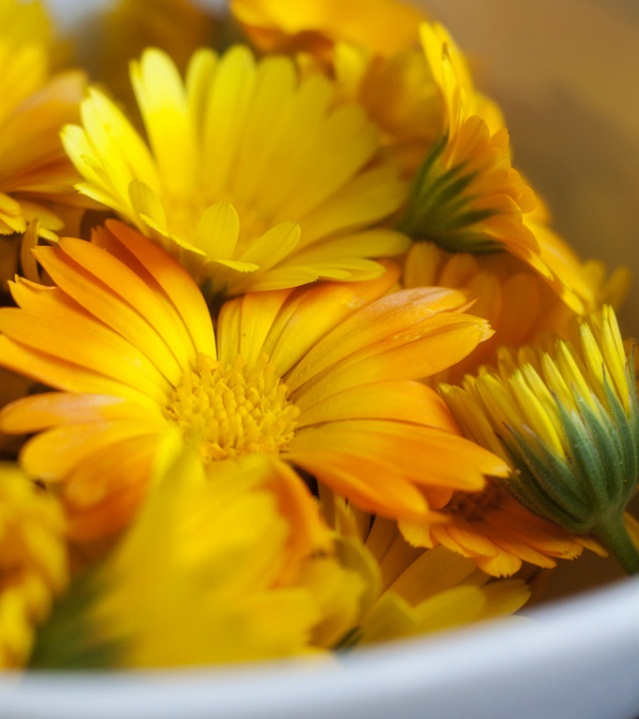Calendula is a flowering plant with tall, branched and hairy stems and an abundance of orange or yellow flowers. They are found in meadows and along roads, railways and fences. Calendula is an annual plant that blooms from May to September.

Calendula flowers have been known since the antiquity for their beneficial properties and even contemporary medicine uses them in the treatment of some cancers and it can be found in the composition of modern products used in the fight against cancer.
Calendula – chemical composition
Calendula flowers contain saponins, mucilage, carotenoids (approx. 3.5%), triterpene alcohols, flavonoids and flavonoid glycosides, sterols, tannins, volatile oil (approx. 0.02%), bitter substances, traces of volatile oil (oxygenated sesquiterpenes), vitamin C, malic acid, minerals and proteins.
Harvest time: harvest calendula flowers without stalks when they are fully developed, after sunrise until the evening dew. Make sure that the petals are free of moisture at the time of the harvesting and dry them in thin layers in the shade.
Using calendula to treat internal and external health problems
For internal use: calendula has a remarkable therapeutic effect in the treatment of diseases such as gastric and duodenal ulcer, jaundice, cancerous ulcers, hemorrhoids, inflammation of the colon and liver diseases.
For external use: calendula can be used in tincture, tea, infusion or ointment to treat conditions such as fungal infections, infected wounds, acne, leucorrhea, burns, ulcers, breast and skin cancer.

Calendula infusion
Add 2 heaping tablespoons of dried calendula flower in 350 ml boiling water. Drink the resulting tea hot, three times a day, half an hour before main meals. For a more concentrated infusion, add 4 tablespoons of calendula flowers to 250 ml water; drink 3 teaspoons per day.
Calendula Ointment
Heat up 100 grams of pork lard. Fry 25 g fresh calendula flowers in the lard at low heat, stirring gently for about 10 minutes; remove the pan from the stove and keep it in a cool place for a day. The next day heat up the mixture again, and then strain it through cheesecloth into a jar, squeezing out the remaining residue as well as possible. Use the resulting ointment to treat burns or frostbites.
Calendula tincture
Calendula tincture is obtained from 20-30 grams of freshly picked flowers. Insert the flowers into a jar, and pour over about 100 g 70-80° alcohol until it completely covers the flowers. Keep the jar near a source of heat or in the sun for two weeks. Add 30 drops of calendula tincture to a glass of water and drink this mixture three times a day to regulate your menstrual cycle. Using a mixture of 10-15 grams tincture and 100 g of boiled and cooled water you can make compresses to treat wounds, burns, ulcers and eye diseases. This mixture gives excellent results in cases of leucorrhea.
Calendula tea
Two to three cups of calendula tea daily between meals have an excellent effect in the treatment of hyperacidity and gastritis as well as peptic ulcer. Calendula tea relieves menstrual pain, especially in anemic women. Calendula can be used in baths, gastric tea and tinctures. Calendula compresses moisturize dry skin. Calendula tea is also recommended in treating jaundice, ulcers and uterine lesions.
Calendula flowers are used in baths, tincture and dressing are used to heal wounds such as ulcers, burns, frostbite, acne and eczema, as active substances in calendula stimulate blood flow to tissues, thus accelerating their healing.
